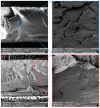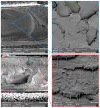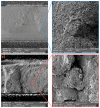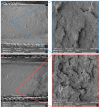Effect of In-Mold Annealing on the Properties of Asymmetric Poly(l-lactide)/Poly(d-lactide) Blends Incorporated with Nanohydroxyapatite
- PMID: 34451374
- PMCID: PMC8398253
- DOI: 10.3390/polym13162835
Effect of In-Mold Annealing on the Properties of Asymmetric Poly(l-lactide)/Poly(d-lactide) Blends Incorporated with Nanohydroxyapatite
Abstract
The proper choice of a material system for bioresorbable synthetic bone graft substitutes imposes strict requirements for mechanical properties, bioactivity, biocompatibility, and osteoconductivity. This study aims to characterize the effect of in-mold annealing on the properties of nanocomposite systems based on asymmetric poly(l-lactide) (PLLA)/Poly(d-lactide) (PDLA) blends at 5 wt.% PDLA loading, which was incorporated with nano-hydroxyapatite (HA) at various concentrations (1, 5, 10, 15 wt.%). Samples were melt-blended and injection molded into "cold" mold (50 °C) and hot mold (100 °C). The results showed that the tensile modulus, crystallinity, and thermal-resistance were enhanced with increasing content of HA and blending with 5 wt.% of PDLA. In-mold annealing further improved the properties mentioned above by achieving a higher degree of crystallinity. In-mold annealed PLLA/5PDLA/15HA samples showed an increase of crystallinity by ~59%, tensile modulus by ~28%, and VST by ~44% when compared to neat hot molded PLLA. On the other hand, the % elongation values at break as well as tensile strength of the PLLA and asymmetric nanocomposites were lowered with increasing HA content and in-mold annealing. Moreover, in-mold annealing of asymmetric blends and related nanocomposites caused the embrittlement of material systems. Impact toughness, when compared to neat cold molded PLLA, was improved by ~44% with in-mold annealing of PLLA/1HA. Furthermore, fracture morphology revealed fine dispersion and distribution of HA at 1 wt.% concentration. On the other hand, HA at a high concentration of 15 wt.% show agglomerates that worked as stress concentrators during impact loading.
Keywords: crystallization; heat resistance; impact resistance; mechanical properties; nanocomposites; nanohydroxyapatite; poly(d-lactide); poly(l-lactide); stereocomplex.
Conflict of interest statement
The authors declare no conflict of interest.
Figures














Similar articles
-
Poly(L-lactide) nanocomposites containing poly(D-lactide) grafted nanohydroxyapatite with improved interfacial adhesion via stereocomplexation.J Mech Behav Biomed Mater. 2018 Feb;78:10-19. doi: 10.1016/j.jmbbm.2017.10.036. Epub 2017 Oct 31. J Mech Behav Biomed Mater. 2018. PMID: 29128694
-
Crystallization, rheology and mechanical properties of the blends of poly(l-lactide) with supramolecular polymers based on poly(d-lactide)-poly(ε-caprolactone-co-δ-valerolactone)-poly(d-lactide) triblock copolymers.RSC Adv. 2019 Aug 20;9(45):26067-26079. doi: 10.1039/c9ra04283k. eCollection 2019 Aug 19. RSC Adv. 2019. PMID: 35531016 Free PMC article.
-
Structure Mediation and Properties of Poly(l-lactide)/Poly(d-lactide) Blend Fibers.Polymers (Basel). 2018 Dec 6;10(12):1353. doi: 10.3390/polym10121353. Polymers (Basel). 2018. PMID: 30961279 Free PMC article.
-
Poly(lactic acid) stereocomplexes: A decade of progress.Adv Drug Deliv Rev. 2016 Dec 15;107:97-135. doi: 10.1016/j.addr.2016.04.017. Epub 2016 Apr 25. Adv Drug Deliv Rev. 2016. PMID: 27125192 Review.
-
Poly (lactic acid) blends: Processing, properties and applications.Int J Biol Macromol. 2019 Mar 15;125:307-360. doi: 10.1016/j.ijbiomac.2018.12.002. Epub 2018 Dec 7. Int J Biol Macromol. 2019. PMID: 30528997 Review.
Cited by
-
Modeling and Analysis of Morphology of Injection Molding Polypropylene Parts Induced by In-Mold Annealing.Polymers (Basel). 2022 Dec 1;14(23):5245. doi: 10.3390/polym14235245. Polymers (Basel). 2022. PMID: 36501641 Free PMC article.
-
The Injection Molding of Biodegradable Polydioxanone-A Study of the Dependence of the Structural and Mechanical Properties on Thermal Processing Conditions.Polymers (Basel). 2022 Dec 16;14(24):5528. doi: 10.3390/polym14245528. Polymers (Basel). 2022. PMID: 36559895 Free PMC article.
-
Morphology Distribution in Injection Molded Parts.Polymers (Basel). 2024 Jan 26;16(3):337. doi: 10.3390/polym16030337. Polymers (Basel). 2024. PMID: 38337227 Free PMC article.
References
-
- Nagalakshmaiah M., Afrin S., Malladi R.P., Elkoun S., Robert M., Ansari M.A., Svedberg A., Karim Z. Green Composites for Automotive Applications. Woodhead Publishing; Sawston, UK: 2019. Biocomposites: Present trends and challenges for the future; pp. 197–215.
-
- Ganapini W. Bioplastics: A Case Study of Bioeconomy in Italy. Edizioni Ambiente; Milan, Italy: 2014.
-
- Watkins E., Schweitzer J.-P. Think 2030. Brussels: Institute for European Environmental Policy (IEEP) IEEP; Brussels, Belgium: 2018. Moving towards a circular economy for plastics in the EU by 2030.
-
- Masutani K., Kimura Y. Synthesis, Structure and Properties of Poly(Lactic Acid) Springer; Cham, Switzerland: 2017. Present situation and future perspectives of poly (lactic acid) pp. 1–25.
-
- Fiorentino G., Ripa M., Ulgiati S. Chemicals from Biomass: Technological versus Environmental Feasibility. A Review. Biofuel. Bioprod. Biorefin. 2017;11:195–214. doi: 10.1002/bbb.1729. - DOI
Grants and funding
LinkOut - more resources
Full Text Sources

